>
Fencing Buying Guide
This guide will cover the topics below. Click a topic to go straight to the information you need.
Fencing Decision 2: Traditional, Modern or Decorative Fencing
Fencing Decision 3: Other Fence Panel Types
Fencing Decision 4: Fences for Special Purposes
Fencing Decision 7: Posts and Accessories
Fencing Decision 8: Fencing Costs for Different Kinds of Fences
Your fence is part of your garden but sometimes it needs replacing. Here are some reasons you may need to install a new fencing run:
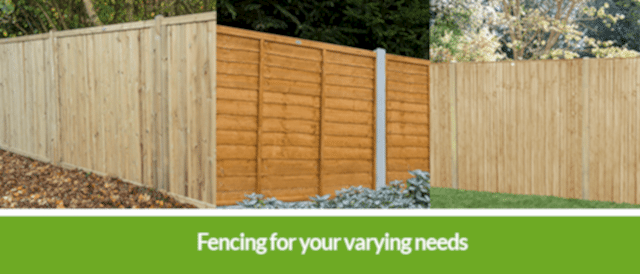

- You want to give your garden a facelift with a new style of fencing
- You have moved into a new home and the outdoor space needs boundaries
- The wind has damaged your fence, and it is unstable or broken
- Your fence has rotted and is no longer solid
All of these are excellent reasons to invest in a new fence, therefore, buy fence panels, fence posts and a variety of fence supplies that you will need.
When you take a first glance at the products available, the world of fencing can seem confusing: What are the differences between treatments? Would I like to buy traditional fencing or decorative fence panels? Which fence is actually mine?
Well, our fence buying guide is here to answer those questions and lots of others that may arise.
Let’s get started.
This guide will cover the topics below. Click a topic to go straight to the information you need.
Fencing Decision 2: Traditional, Modern or Decorative Fencing
Fencing Decision 3: Other Fence Panel Types
Fencing Decision 4: Fences for Special Purposes
Fencing Decision 7: Posts and Accessories
Fencing Decision 8: Fencing Costs for Different Kinds of Fences


Fence Panel Dimensions - How wide are fence panels?
One of the first questions is often: “How wide are fence panels?” Let us break down the standard fence panel dimensions for you.
The UK standard for fence width is 6 feet, height options include:
- 3 feet and 4 feet fence panels – these are most commonly used for low-height fencing, which makes them especially popular to use in front gardens
- 5 feet and 6 feet fencing panels - provide increased privacy and security, these are popular in back gardens
Trellis panels are generally shorter with popular sizes being 1ft and 2ft high. Popular options include fence toppers, planter trellis and wall trellis.
Fence panel measurements
Not all 6x6 fence panels are exactly 6x6. The same goes for all other fence sizes. These are approximate fence panel measurements that act as a starting point. Because of the difference in European and Standard fence shapes, some 6x6 panels are 5’11” x 5’11”. ALWAYS check the specification guide on each product page for precise, detailed measurements.
There are limitations and restrictions on fence height in the UK. If you are unsure, have a quick read of our blog: How tall can my fence be?
Shop by Popular Fence Panel Sizes
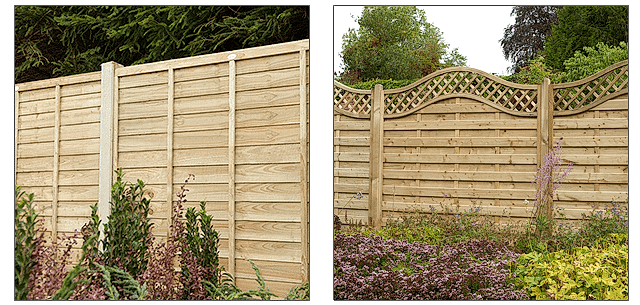

An important part of the decision-making process is deciding what type of fencing you would like. This includes traditional, modern and decorative styles:
Traditional Fencing Construction
Classic fencing is timeless, secure and is popular in many gardens. Examples of traditional fencing include overlap, closeboard panels and picket fencing, which are popular choices and look sturdy and familiar.
Related article - A History of Fencing – The Timeless Appeal of Traditional Fence Styles.


Overlap Fencing
A great value and cost-effective option, overlap fencing provides privacy and a traditional look for any garden:
- Affordable – one of the most affordable traditional fence panels
- Easy-to-install – simple to install with minimal tools required
- Maintenance – needs treatment to prevent rot and extend life
- Private – overlapping panels give solid coverage with no gaps
- Rustic – traditional wooden design suits classic gardens


Closeboard Fencing
Strong and durable, closeboard fencing is popular for secure and long-lasting boundaries:
- Classic – suits both traditional and modern gardens
- Pressure treated wood – closeboard panels are usually designed to resist rot and extend life
- Secure – solid panels create a strong perimeter
- Strong build – built with overlapping vertical boards for extra strength
- Various heights – available in different heights to suit your needs
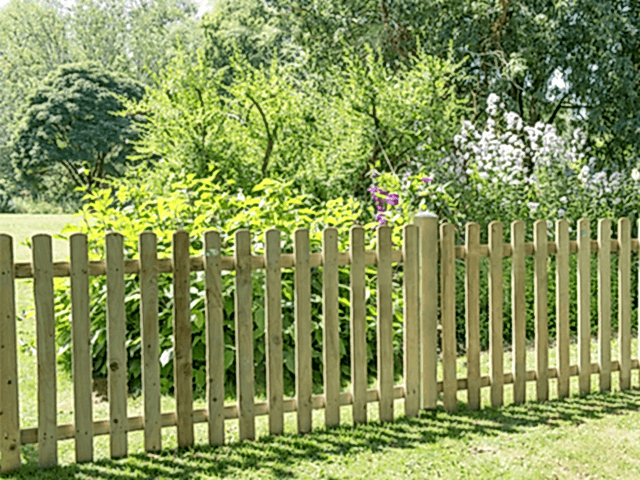

Picket Fencing
A pretty and decorative option, picket fencing offers a balance of style and function for front gardens and pathways:
- Classic look – instantly recognisable, and are perfect for cottage gardens
- Custom designs – available in different heights and gap widths
- Defined boundaries – they are great for marking property edges without blocking views
- Low-maintenance – they can be painted (white is popular) or stained for extra protection
- Pet and child-friendly – a safe and decorative boundary, which contains pets and children safely
Shop Picket Fencing – learn in our blog article: What is the Typical Cost of a Picket Fence?
Modern fencing
Combining style with practicality, modern or contemporary fencing creates a smart boundary. Popular modern fence panels are slatted, hit and miss fencing, and composite fencing provide a clean finish with added durability.
Related blogs
1) Top 9 Contemporary Fencing Ideas for a Stunning Garden Transformation
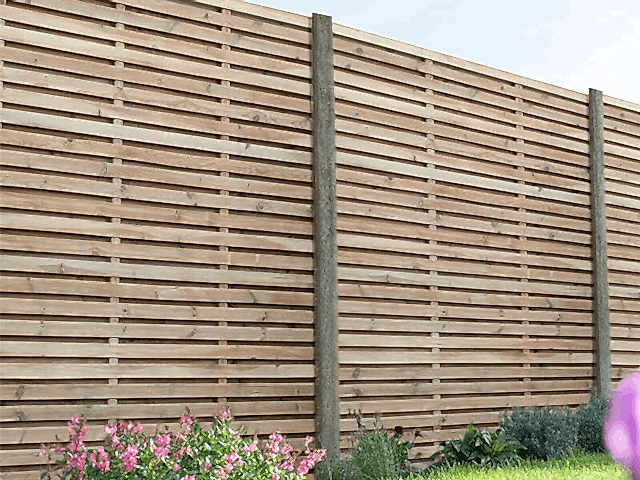

Slatted Fencing
Giving a modern look, slatted fencing lets air and light through:
- Horizontal – the timber slats are generally horizontal for a clean modern look
- Material choice - available in pressure treated wood, composite, or metal material
- Minimalist - a minimalist design (especially pre-painted grey versions) for modern landscapes
- Options - include garden dividers, pergola screening or full boundary fencing
- Partial privacy - without blocking all light
- Single or double - buy these modern fence panels in either single slatted or double slatted versions
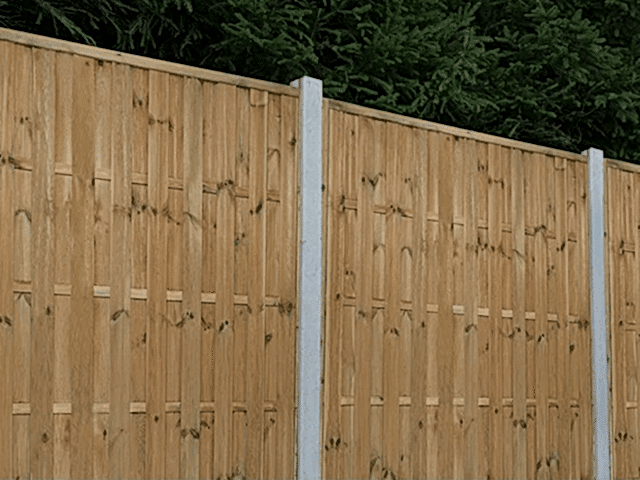

Hit and Miss Fencing
Adding strength and style, hit & miss fencing aids air flowing through while keeping you private:
- Gaps between boards - allow wind to pass through, which reduces pressure on the fence
- Material options - timber or (sometimes) composite material, for durability and longevity
- Modern - a modern fence panels look with the strength of traditional fencing
- Same look on both sides - alternating horizontal or vertical boards for the same look on both sides
- Versatile - used as boundary fencing, garden screening, and in commercial properties
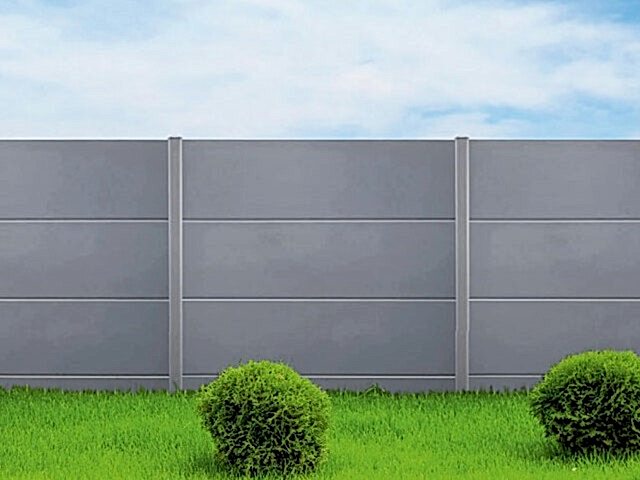

Composite Fencing
A low-maintenance, durable alternative to traditional fence panels, composite fencing has a modern look with weather resistance:
- Contemporary fence panels - which are available in many colours and finishes to suit your garden style
- Material options - made from wood fibres and recycled plastics for extra longevity
- Qualities - excellent privacy and sound insulation and eco-friendly
- Resistant - rot, warping, and insect damage-resistant for long-term use
- Same look on both sides - no painting, staining, or sealing is required
Decorative Fence Panels
Add personality, flair, and glamour to outdoor spaces with decorative fencing, while maintaining privacy and security. Examples include trellis panels, woven fencing and lattice-topped panels, which add texture and interest to any garden.
Related blogs:
1) Decorative Fencing Ideas - Exploring the World of Decorative Garden Fence Panels
2) Decorative Wildlife-Friendly Fencing - Ideas & Inspiration
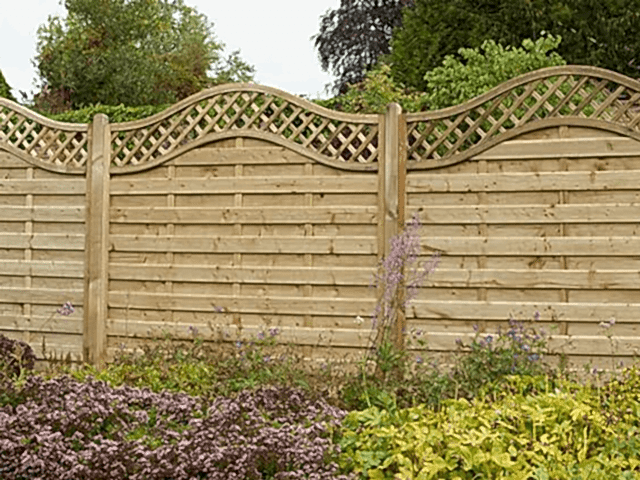

Lattice Fencing
Adding a stylish touch to gardens, lattice fencing is perfect for climbing plants and boundaries:
- Balance - provides a balance of both privacy and airflow
- Climbing plants - ideal for climbing plants such as roses, wisteria, and clematis
- Criss-crossed wooden slats - for an elegant open design
- Implementation options - can be used as a standalone fence or as a topper for solid panels
- Various patterns - including square and diamond designs
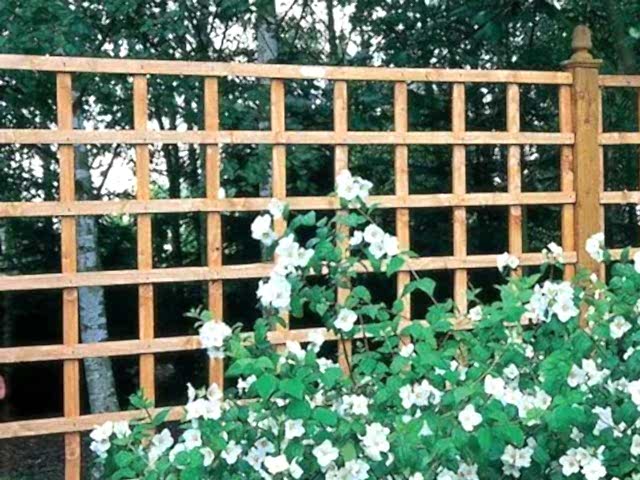

Trellis Panels
Add height and interest with trellis panels which create garden boundaries and support climbing plants:
- Climbing plants - embraces vertical gardening and training climbing plants such as roses, ivy, wisteria, and clematis
- Design options - square, diamond, and decorative lattice designs are available
- Installation options - can be used as freestanding garden screens or fixed to fence panels
- Material options - timber or metal with pressure treated options for durability
- Provides privacy - while allowing airflow and light through
Learn here How to attach a trellis to a fence or wall.
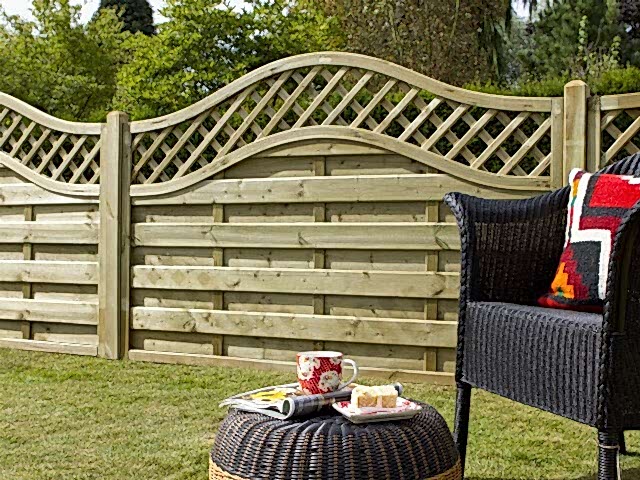

Lattice Topped Panels
Combine solid fencing with a decorative lattice top with lattice-topped panels which gives a finished look:
- Many heights and designs - are available, including straight and arched tops
- Pressure treated timber - to resist weathering and decay
- Privacy - with some visibility and airflow through the top section
- Stylish - the lattice adds a stylish touch to standard fence panels
- Uses - for defining garden boundaries and supporting light climbing plants
Read our related article - Fencing Extension Ideas Using Toppers & Extenders.
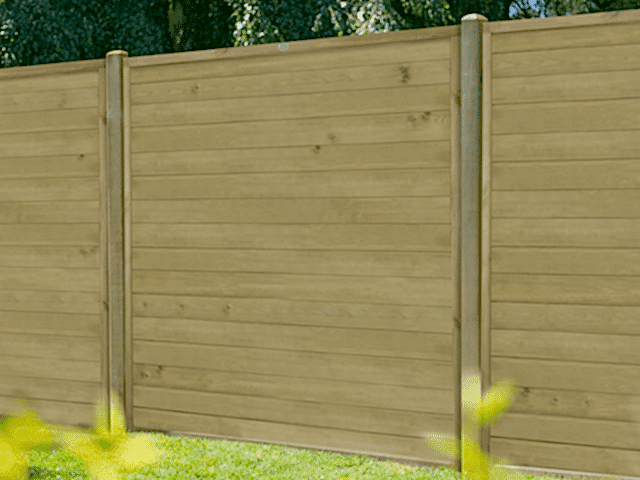

Tongue and Groove Fencing
Giving you premium solid construction, tongue & groove fencing provides maximum privacy and noise reduction:
- Complete privacy - with no gaps between boards
- Highly effective - at reducing road and neighbour noise
- Interlocking boards - for seamless fence panel
- Strong and durable - for secure boundary fencing
- Treatment options - pressure treated or dip treated for long-term protection


Grey Fencing
Modern fencing with a sleek look, grey fencing panels are pre-painted. This makes them an excellent choice for contemporary gardens, but they work well in traditional settings too:
- Available in a variety of styles - including slatted, and overlap designs
- Low maintenance - with some options requiring only occasional cleaning
- Made from durable materials - such as pressure-treated wood, metal, or composite
- Provides a neutral, stylish finish - that complements various garden themes
- Resistant to fading and weathering - which maintains their appearance for longer
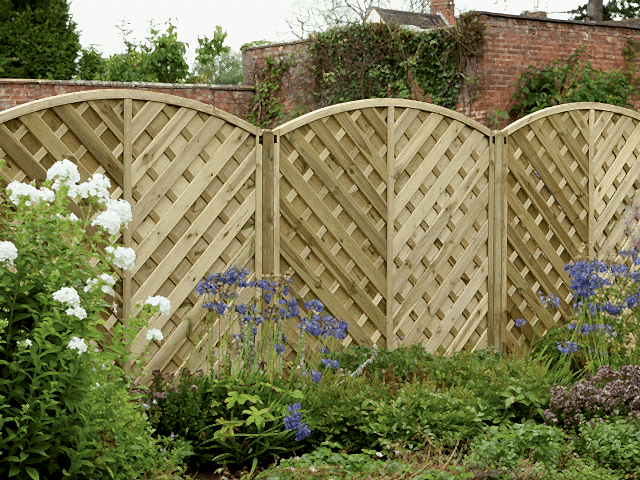

Dome Top Fencing
This is a classic fencing choice that blends traditional design with functional security:
- Aesthetic appeal - perfect for use in both front and back gardens, enhancing the overall look of your outdoor space
- Customisable - can be easily customised with accessories, such as caps or post toppers, for a unique finish
- Decorative garden panels - which add a decorative touch while providing effective privacy and protection
- Natural wood finish - can be stained or painted to match various garden aesthetics
- Size options - available in different heights and widths to suit various garden designs
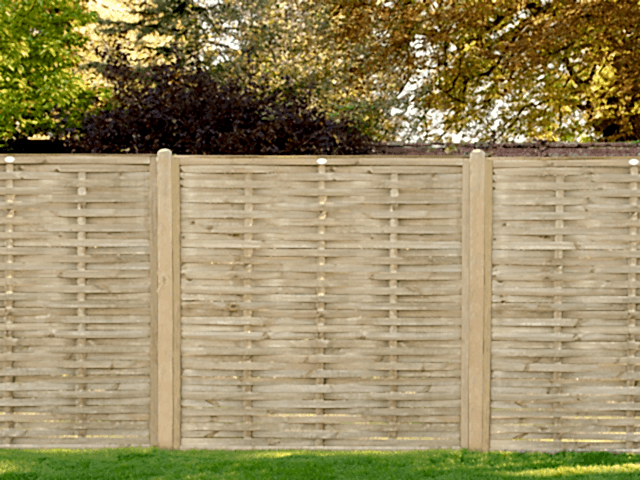

Woven Fencing
A natural, rustic look, woven fencing blends in with both traditional and modern gardens:
- Décor settings - cottage-style gardens and rural landscapes love it
- Interwoven wooden slats - for a unique texture
- Pressure treated wood - for long-lasting durability
- Semi-private screen - with some light and air through
- Usage options - can be used for full fencing runs or as decorative garden dividers
Eco-friendly Fencing
Eco-friendly fencing provides a sustainable and stylish solution for securing your garden while reducing environmental impact:
- Durable and long-lasting – designed to withstand the elements, many eco-friendly options have a longer lifespan than traditional fencing
- Energy-efficient production – many eco-friendly fences are manufactured using processes that lower carbon emissions and conserve resources
- Low maintenance – requires little to no treatment, reducing the need for chemical preservatives and frequent replacements
- Recyclable and biodegradable – some materials can be repurposed or naturally decompose at the end of their lifespan
- Sustainable materials – often crafted from recycled plastics, bamboo, or responsibly sourced timber to minimise deforestation
For further details read our comprehensive blog - Go Green: Eco-Friendly Fencing & Sustainable Fence Materials.
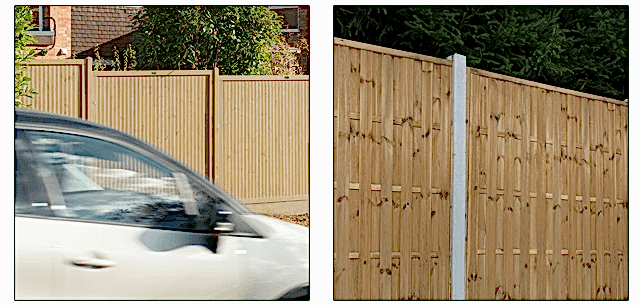

Noise-reduction fencing
If your home is near a road, school or noisy area, noise-reducing fence panels could be the answer. These award-winning tongue and groove panels can cut noise by up to 30dB.
Fencing for uneven ground
If your garden has a slope, you will need to step your fence panels. More information on this is provided in our "Fencing Installation" section below. On very uneven ground individual fence boards may be better than panels, giving more flexibility to follow the contours of the land. Our blog How to Install a Fence on Sloped or Uneven Ground provides massive insight on this topic.
Wind-exposed fencing
If you live in a very windy area, like a hilltop, consider fencing with gaps between the boards, such as Hit & Miss fencing. This allows the wind to pass through and reduces pressure on the panels. For added privacy with solid fencing opt for longer posts, and slotted fence posts to secure the panels better.
Related blogs
1) Coastal Fencing Ideas for Beach Homes & High Wind Areas
2) Identifying a Storm Damaged Fence - Preventative Actions To Take, With Legal & Insurance Insights
Fencing on hard surfaces and concrete
When installing fencing onto concrete, the same panels and posts can be used but you will need a fence post shoe (or bolt-down post support). This will secure the post into the shoe which is then bolted to the surface. Unlike fencing in grass, you do not need extra post length for concrete as the posts don't need to be buried.


Fencing on top of a wall
If you want to add fencing on top of a wall, such as a low front garden wall, there are several options. If the wall is wide enough the above post shoes can be used. But for narrower walls drilling could damage the structure so bolting the posts to the wall or fixing them in the ground at the base may be better. If your wall has brick columns you could also fix horizontal arris rails between the columns and attach individual boards to complete the fence.
Front garden fencing
The style and size of your fence panels are key when designing a front garden fence. Front garden fencing is the first impression of your home and plays a big part in the curb appeal. For more information, check out our “Front garden fence ideas” post.
Dip Treating of Fence Panels and Posts
Dip treatment is a common method used to treat various types of wooden fencing panels and posts. The timber is submerged in a bath of preservative solution. The treatment penetrates deep into the wood.
This protects the timber from rot, fungi and insect infestations. Dip treatment offers a basic level of protection and gives the wood a uniform colour and is often used for panels that will be installed in less exposed areas. However, dip treated panels are not as durable as pressure treated wood.
Pressure treating of fence panels and posts
Pressure treatment involves forcing a fence preservative into the wood under pressure, which penetrates deep into the timber. This gives a higher level of protection than dip treatment and the wood is more resistant to rot, decay and insect damage. The pressure treatment process is completed in a vacuum chamber, so the wood absorbs the preservative fully.
Pressure treated fencing panels and posts are designed to last much longer, often with 15-year warranties or more. The treatment is ideal for timber that will be exposed to the elements as it gives long-term durability in harsher conditions. Unlike dip treated wood pressure treated timber requires less maintenance over time as the fence preservative is deep into the wood.
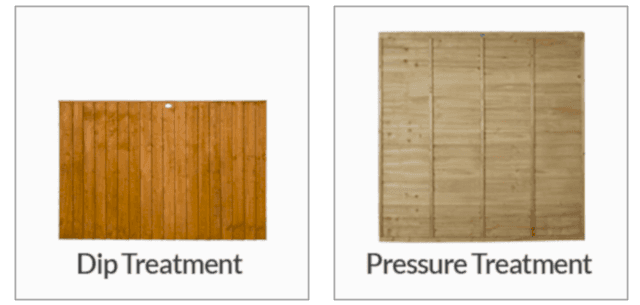

Types of Fencing - Dip Treated vs Pressure Treated
When deciding between dip treated and pressure treated fencing the main consideration is the level of protection your fence needs. Dip treated panels are soaked in a preservative solution to protect the wood but the treatment only covers the outer layers so they may need re-treating every few years.
Pressure treated fencing has the preservative forced deep into the timber under high pressure so offers much greater durability and protection against rot and pests.
Therefore, pressure treated panels are ideal for areas exposed to harsh weather or where long-lasting protection is required. Dip treated fencing is cheaper initially but may cost more in the long run due to the shorter lifespan and annual fence preservative costs. Pressure treated fencing is more expensive to start with but is better value in the long run due to the longer lifespan.
Both types of fencing should be installed with gravel boards which sit at the bottom of the fence to prevent contact with the ground, in doing so, they extend the life of your fence by reducing the risk of water damage.
Can Fences Be Painted or Stained Later and Act as a Form of Fencing Treatment?
Yes, fences can be painted or stained later and that in itself provides an extra layer of protection. Paint and stain will protect the wood from moisture, UV and weathering. But they do not replace proper treatment like dip or pressure treatment which protects the wood from the inside. Regular maintenance including reapplying paint or stain will however extend the life of the fence.
Fencing Treatment-Related Blogs
1) Ultimate Guide to Fence Post Protection & Preservation using Gravel Boards & Wood Preserver
2) How to Paint a Fence - Tips & Advice
Fencing Decision 6: Gates
Depending on the area of your garden that you are fencing, you may require a gate to complete your fencing run.
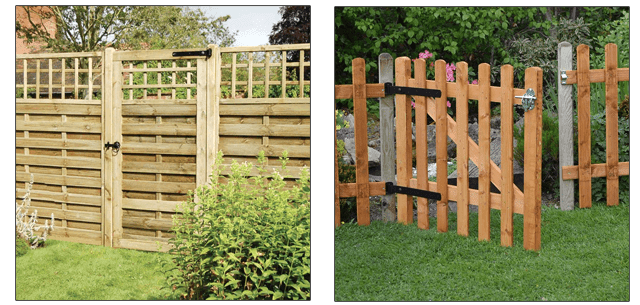

What are the Main Purposes of Gates?
Gates serve many purposes in both domestic and commercial settings:
- Security and privacy – a gate is a physical barrier that helps protect your property from intruders and privacy from passers-by. An effective gate makes it harder for unauthorised people to get onto your property
- Access control – gates are for managing access to your property for family members, deliveries or guests. They allow you to control who comes and goes into your garden or driveway, making it safer and more convenient
- Aesthetic appeal – a gate finishes off your garden or driveway, adding to the overall look. The right gate will complement your property’s style, making it more welcoming or match the surrounding fencing
Buying Matching Fence Panels and Gates
Most fence panel ranges come with matching gates so you can have a seamless look across your boundary. This means your gate will not clash with the fence and will look uniform.
Choosing a matching gate and fence panel design will enhance the look of your property while giving you the security and access you need.
Gate Related Blogs
1) Exploring the Best Garden Gate Designs for Your Home
2) Gate Types - Electric vs Manual, Which is Best for Your Garden?
3) Gate Types - Finding the Right Fit for Your Garden – Gate Design Ideas & Styles
4) How to Add A Garden Gate Into a Fence
5) How to Fit & Install a Garden Gate
6) The Art of Repair and Fixing a Garden Gate to Keep Your Garden Entrance
7) The Best Metal Gate Designs & Types of Metal Gates for Home Security & Creating a Lasting Impression
8) Top 5 Wooden Garden Gate Ideas - Best Designs & Modern Gate Inspirations
9) Which Type of Garden Gate is Best for my Property
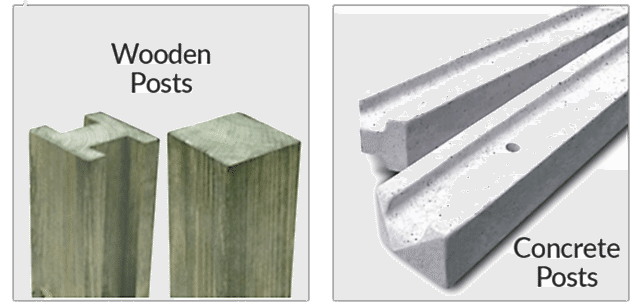

Fence Posts – Wooden vs Concrete
Wooden fence posts need to be pressure treated, as they do the hard work of being buried underground year after year. They look natural and are aesthetically pleasing, are easier to manoeuvre and can be a little more forgiving if your measurements are out a millimetre or two. Pressure treated posts do not require annual treatment but should be checked regularly for damage and stability. Related blog - How Long Do Wooden Fence Posts Last & How to Increase Their Life Expectancy.
A concrete fence post is much stronger but lacks the charm of timber. Concrete requires no maintenance except the occasional wipe-down if algae build up. They are a reliable, easy option for supporting your fence panels.
For further information on this topic, read our blog articles:
1) How to Choose the Best Fence Posts: Concrete vs Wood
2) How to Prevent Fence Post Rot & Select Long-Lasting Fence Posts


How to Calculate the Height of Fence Posts Required
As a rule of thumb, the one-third rule applies, i.e. for the fence post, one-third is buried, and two-thirds are above ground. This is subject to a minimum of 2ft underground, so bury one-third, or 2ft underground, whichever is greater.
As an example, if you have a 5ft high fence, you need a 7ft fence post. In situations, where you use a gravel board (which we highly recommend), this will raise the fence panel. You will need to take the height of the gravel board into account too.
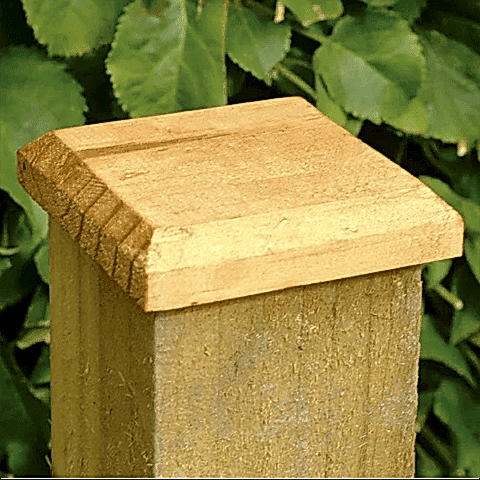

Do I Need Post Caps or Finials?
The end of the post is the most vulnerable above ground area of a fence post. Rain, frost and snow will naturally gather here. Post caps add protection against moisture and are designed to prevent water accumulation.
Finials are added for decorative appeal and are purely a matter of personal taste.
Shop fence post caps and finials
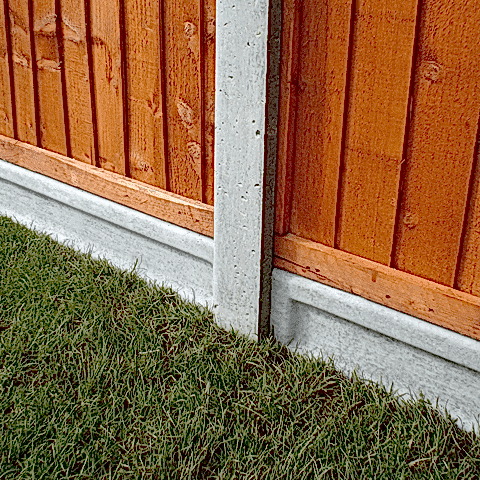

Is a Gravel Board Required?
When buying dip treated fence panels, we strongly recommend you use gravel boards. The gravel boards are either made from concrete or timber that has been pressure treated to resist rot and fungal disease. The ultimate purpose of gravel boards is to protect your fencing panels from moisture and dampness.
Even with pressure treated panels, gravel boards play a role. They provide a strong protection layer for your fence panels and provide extra support to fence fixings during wind and movement due to temperature changes.
You can choose concrete gravel boards or wooden gravel boards to suit your needs. See the section about fence posts for further thoughts on the difference.
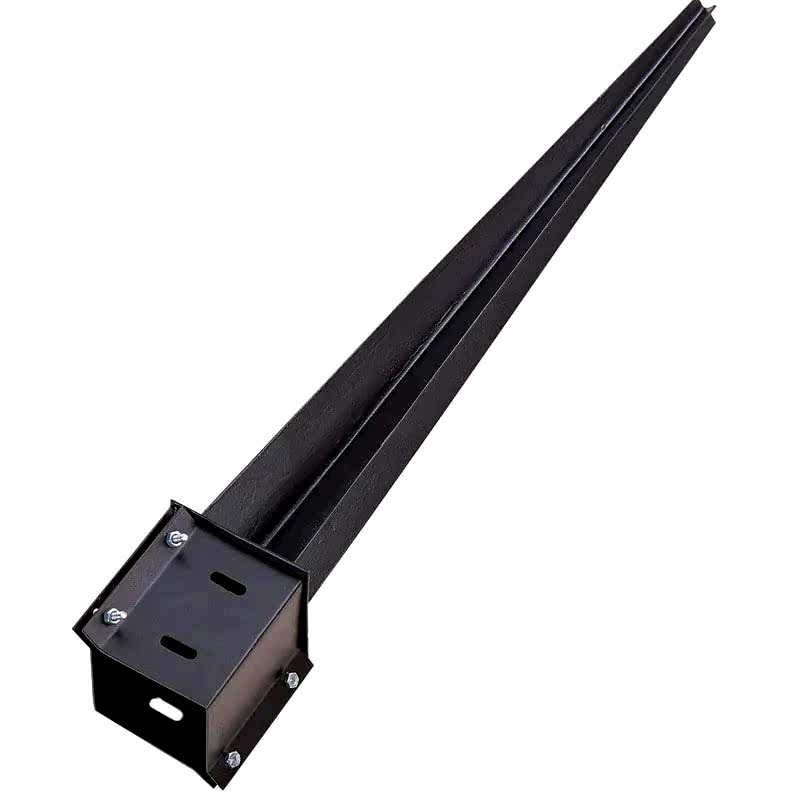

Is the Use of Fence Post Spikes Recommended?
Yes, we think these are a great option and a real alternative to concrete bases. Fence post spikes are metal supports to secure fence posts without concrete. Made from powder-coated steel they are durable and protect the base of the post from rot. The spiked design makes installation easy and provides a solid foundation in any soil.
These save time and effort, so fencing is quicker and less labour-intensive. They are flexible during installation so you can adjust or replace fence posts as needed. They are an eco-friendly alternative to concrete, with no emissions and no drying time.
Read our detailed article here - How to Use Fence Post Spikes - Easy Installation Guide.
Fencing Decision 8: Fencing Costs for Different Kinds of Fences
Below we summarise the likely cost of fencing for various fence panel types.
Fencing costs table
Below is a fencing costs table for five popular fencing styles with accompanying notes underneath:
| Panel Cost Each*1 | Overlap | Close Board | Slatted | Hit & Miss | Tongue & Groove |
| 6’x3’ | £25 | £51 | £71 | N/A | N/A |
| 6’x4’ | £26 | £51 | £73 | £65 | N/A |
| 6’x5’ | £28 | £59 | £84 | £81 | N/A |
| 6’x6’ | £31 | £60 | £70 | £74 | £109 |
| Costs for a 36’ run (6 panels) | Overlap | Close Board | Slatted | Hit & Miss | Tongue & Groove |
| 6’x3’ | £150 | £306 | £426 | N/A | N/A |
| 6’x4’ | £156 | £306 | £438 | £510 | N/A |
| 6’x5’ | £168 | £354 | £528 | £486 | N/A |
| 6’x6’ | £186 | £360 | £420 | £444 | £654 |
| Ground preparation*2 | £0 if DIY | £0 if DIY | £0 if DIY | £0 if DIY | £0 if DIY |
| Wooden Fence Posts – Price for 7 Posts*3 | Overlap | Close Board | Slatted | Hit & Miss | Tongue & Groove |
| 6’x3’ – 5’ Posts | £71 | £71 | £71 | £71 | £71 |
| 6’x4’ – 6’ Posts | £119 | £119 | £119 | £119 | £119 |
| 6’x5’ – 7’ Posts | £103 | £103 | £103 | £103 | £103 |
| 6’x6’ – 8’ Posts | £110 | £110 | £110 | £110 | £110 |
| Gravel Boards (Optional)*4 | £0-£231 | £0-£231 | £0-£231 | £0-£231 | £0-£231 |
| Concrete for Posts | £35-£100 | £35-£100 | £35-£100 | £35-£100 | £35-£100 |
| Accessories – screws, brackets, supports | £120 | £120 | £120 | £120 | £120 |
| Treatment | £40-£150 | £40-£150 | £40-£150 | £40-£150 | £40-£150 |
| DIY fence installation cost*5 | £0-£220 | £0-£220 | £0-£220 | £0-£220 | £0-£220 |
| Professional installation*6 | Overlap | Close Board | Slatted | Hit & Miss | Tongue & Groove |
| 6’x3’ – 5’ Posts | £75-£110 | £75-£110 | £75-£110 | £75-£110 | £75-£110 |
| 6’x4’ – 6’ Posts | £87-£125 | £87-£125 | £87-£125 | £87-£125 | £87-£125 |
| 6’x5’ – 7’ Posts | £100-£150 | £100-£150 | £100-£150 | £100-£150 | £100-£150 |
| 6’x6’ – 8’ Posts | £112-£187 | £112-£187 | £112-£187 | £112-£187 | £112-£187 |
Notes:
*1 – Prices quoted are a minimum price, rather than the highest for that type of panel
*2 – Ground preparation is assumed to be DIY, so no actual cost is incurred. This may vary depending on the conditions:
- 2 to 4 hours if the ground is soft and level, requiring only minor digging and levelling
- 4 to 6 hours if the ground is uneven, rocky, or has old posts that need removing
- 6+ hours if concrete bases or extensive levelling is required before installing the panels
*3 – Costs are illustrated for a wooden fence post. Note: the post will always be 2’ higher than the panel as 2’ will be buried underground. So, a 6’x3’ fence panel, would need a 5’ fence post. For a 36’ fencing run, 7 posts would be required, as one extra post is needed than the number of panels, to have one post at each end.
*4 – One gravel board is required per fence panel. So, six gravel boards are required for the six fence panels in a 36’ fencing run
*5 – DIY installation – although the labour is free, there will be some costs associated with tool purchase/hire. There may be a need to buy/hire:
- Post hole digger or spade: £20 to £50
- Spirit level: £10 to £20
- Drill & bits: £40 to £100 (if needed)
- Saw (if cutting panels or posts): £15 to £50
*6 - Estimated professional installation times per panel. (This includes post digging, post setting, and panel fixing but not ground preparation.)
| Panel Size | Time Per Panel | Total Time for 36' Run (6 Panels, 7 Posts) |
| 6' x 3' | 30 - 45 mins | 3 - 4.5 hours |
| 6' x 4' | 35 - 50 mins | 3.5 - 5 hours |
| 6' x 5' | 40 - 60 mins | 4 - 6 hours |
| 6' x 6' | 45 - 75 mins | 4.5 - 7.5 hours |
Multiply by an average rate of £25 per hour to calculate the installation costs.
Why can DIY Installation Costs be Higher than Professional Installation Costs?
Relatively speaking the cost of installing a 36’ fencing run, even for 6’x6’ fencing is modest at just 7.5 hours. This means that often the cost of buying or hiring tools, especially for smaller heights can be higher than just using trade professionals. Although it is true to say in the case of buying tools that you get to keep these as well as complete the installation.
Fencing Installation
If you have decided on a DIY installation approach, we have a variety of resources to help you along the way.
Fencing Installation or Repair Blogs
Check out these fencing installation and fencing repair-related blogs:
1) A Comprehensive Guide to Replacing a Fence Panel
2) Building Picket Fences - A Step-By-Step DIY Picket Fence Installation Guide
3) Can I Install a Fence on my Driveway?
4) How to Calculate Fence Installation Costs
5) How to Dig a Fence Post Hole - Tools & Expert Tips
6) How to Install a Fence - here you will find a checklist of the equipment needed to build a fence plus a visual video guide to building a fence
7) How to Install a Fence Post Into Soil
8) How to Install Roofing Felt on a Shed
9) How to Repair a Wooden Fence
10) How to Spot & Repair Wooden Fence Hail Damage
11) Installing a Wooden Fence - How Long Does It Take to Put Up a Fence?
12) Installing Fence Posts - Expert Tips on How to Set & Install a Fence Post Properly
13) Repair or Replace: A Guide to Fence Panel Replacement vs Fixing a Fence
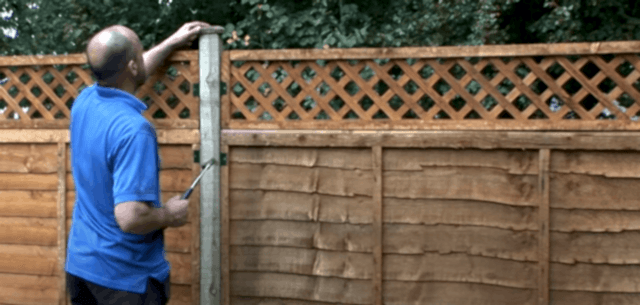

When constructing fencing on uneven terrain, the installation method will differ from that on flat ground. This will result in a “stepped” fence design. The fence post height should match the taller panel in each set of adjoining panels. Ensure that all fence panels remain level throughout the process. Gravel boards are crucial and usually need to be partially underground for stability, depending on how steep your slope is. Though we do not have a specific video for this, you will find many options on YouTube.
Installation of wooden fencing types
For those who are not confident with DIY, you can find recommended tradesmen via Checkatrade.com. Follow our link here to go straight to fencing services.
BEFORE you begin, make sure you know the answers to the following questions:
You do not want to fall foul of planning regulations and be forced to take down your freshly installed fencing.
Is Cheap Garden Fencing Available?
Yes, infact we have a cheap fence panels category. This exclusively lists our overlap fencing, which is always the most cost-effective, cheap garden fencing of our wooden fencing types. For more details on how to buy a fence at low-cost, visit our blog article – What Are the Most Economical & Affordable Fencing Options?
Other Fencing-Related Articles
We have added links to many different fencing blogs throughout this Fencing Buying Guide. This is where we found a direct fit for the topic. Here are some other fencing blogs, that may be of interest:
1) Allotment Fence Ideas - Secure Allotment Fencing Solutions for Every Season
2) An A-Z of Garden Fencing Terms, Words, Jargon, Vocabulary & Gate Related Phrases
3) Best Fencing for Pets, Dogs and Cats
4) Fence Safety - How a Garden Safety Fence Can Help
5) Garden Fence Design - Creative Fence Panel Ideas & Layouts
6) How to Grow Vines and Plants on a Fence
7) Simple Fence Line Landscaping Ideas & Best Plants for Fence Lines (Low Maintenance Tips)
8) Stylish Garden & Patio Privacy Fencing Ideas
9) The Best Options for Maintenance-Free & Low Maintenance Fences
10) The Ideal Fencing for Small Gardens
11) The Ultimate Garden Fencing Tools List - Essential Equipment, Materials & Tools Needed to Build a Wooden Fence
12) Unique Landscape Fencing Ideas to Set Your Garden Apart


How Soon Will Delivery be Available?
Many fencing products offer the convenience of a pick-a-day as a delivery option. This allows you to choose your preferred delivery date before completing your purchase. Availability of this option will be displayed on any product page.
Where pick-a-day is not an option, check the lead times listed for each item, which will indicate when the product can be dispatched. Once dispatched, the manufacturer will contact you directly to schedule a delivery time.
What are the Delivery Charges?
All products are supplied with free delivery, except for decking and fencing orders with a value below £100. Orders valued over £100 for fencing and decking are delivered free of charge, while orders below £100 will carry a fixed £24.99 delivery fee.
Certain remote areas may be subject to additional delivery charges, even where free delivery or minimum order value has been reached. To check whether your postcode is eligible for free delivery and to verify any applicable fees, use our postcode checker service. This is available on any of our product pages sitewide.


If you have further fencing-related questions, or even on other outdoor living topics why not contact our friendly UK-based team? Reach us through any of these methods to discuss different kinds of fences:
- Phone - 0333 003 0515
- E-mails – these can be sent by using the contact form on our Contact Us Page
- Live Chat – text chat with us in real time using our live chat feature. Access this by clicking the orange icon at the bottom left of any page













